2023年成果展示
发布时间: 2024-09-03 访问次数: 17
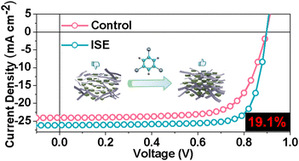
Energy Environ. Sci., 2023, 16, 3441–3452
Graphical abstract:By the delicate coordination of film-formation kinetics, we propose an intermediate state engineering (ISE) strategy to yield efficient, thickness-insensitive and robust OSCs. Using Y6 as a demonstration, inspired by its superior intermolecular interaction with the dithienothiophen[3.2-b]pyrrolobenzothiadiazole (BTP) core in the Y6 molecule, a 1,3,5-tribromobenzene (TBr) solid additive would trigger a distinct TBr:Y6 intermediate phase, which would facilitate self-aggregation behavior and prolong the aggregation kinetics during the drying process. Remarkably, this subtle modulation of BHJ morphology catalyzes inhibited energetic disorder, suppressed trap-assisted recombination and elevated carrier transport and collection capabilities, resulting in a considerable boost in power conversion efficiency (PCE) from 15.9% to 19.1%Benefitting from this superior manipulation facility, a champion PCE of 17.8% is harvested in a thickness of 300 nm after ISE treatment, representing one of the highest efficiencies in thick-film OSCs.
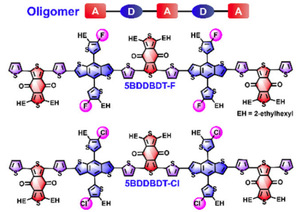
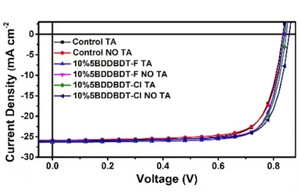
Energy Environ. Sci., 2023, 16, 6078–6093
Graphical abstract:In this study, two A–D–A–D–A type oligomers, named 5BDDBDT-F and 5BDDBDT-Cl, were designed and synthesized to be incorporated into binary OSCs. As a result, using non-halogenated solvent (o-xylene), the best-performing OSCs with PCEs of 18.32% with a VOC of 0.850 V, an FF of 79.15% were achieved based on the PM6:5BDDBDT-F:BTP-eC9 ternary OSCs, and 18.43% with a VOC of 0.854 V, an FF of 79.29% were obtained based on PM6:5BDDBDT-Cl:BTP-eC9 ternary OSCs without any post-processing. More importantly, it is noteworthy that the large-area (1 cm2 ) blade coated devices based on PM6:5BDDBDT-F:BTP-eC9 and PM6:5BDDBDT-Cl:BTP-eC9, processed using non-halogenated solvent in an open-air environment without thermal-annealing treatment, obtained high PCE values of 17.11% and 17.06%, respectively, which are among the highest PCE values of blade-coated OSCs in open air.
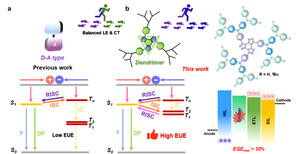
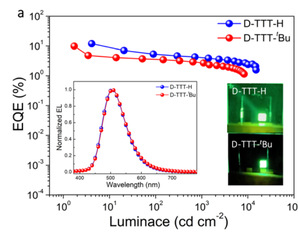
Materials Horizons 11.7 (2024): 1741-1751.
Graphical abstract:Herein, a proof-of-concept design for improving ηS in hot exciton materials is proposed via elaborate regulation of singlet–triplet energy difference, leading to an additional thermally activated delayed fluorescence (TADF) process. Two novel dendrimers, named D-TTT-H and D-TTT-tBu, were prepared and characterized, in which diphenylamine derivatives were used as a donor moiety and tri(triazolo)triazine (TTT) as an acceptor fragment. Compounds D-TTT-H and D-TTT-tBu showed an intense green color with an emission efficiency of approximately 80% in solution. Impressively, both dendrimers simultaneously exhibited a hot exciton process and TADF characteristic in the solid state, as was demonstrated via theoretical calculation, transient photoluminescence, magneto-electroluminescence and transient electroluminescence measurements, thus achieving almost unity ηS. A solution processable organic light-emitting diode (OLED) employing the dendrimer as a dopant represents the best performance with the highest luminance of 15090 cd m−2 and a maximum external quantum efficiency (EQEmax) of 11.96%. Moreover, using D-TTT-H as a sensitizer, an EQEmax of 30.88%, 24.08% and 14.33% were achieved for green, orange and red solution-processed OLEDs, respectively.
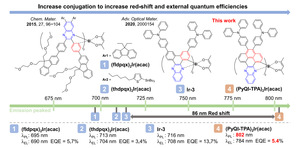
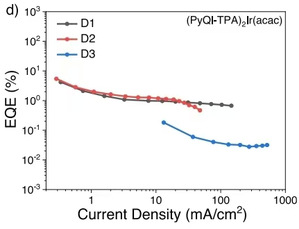
Chemical Engineering Journal 475 (2023) 146031
Graphical abstract:we designed and synthesized two butterfly-type iridium(III) complexes of (PyPz-TPA)2Ir(acac) and (PyQl-TPA)2Ir(acac), in which pyrene-pyrazine (PyPz) and pyrenequinoxaline (PyQl) are respectively used as the rigid C^N bidentate coordinated cocoons, peripherally with two triphenylamine (TPA) units at 4, 5-positions. Their photophysical, electrochemical and electroluminescent properties are primarily investigated. It is found that the (PyQl-TPA)2Ir(acac) presents stronger spin-orbital coupling effect, a smaller ΔEST energy difference, and lower reorganization energy than (PyPz-TPA)2Ir(acac) by selecting rigid pyrene-quinoxaline coordination and optimizing peripheral TPA position. Furthermore, the (PyQl-TPA)2Ir(acac)-doped OLEDs exhibit a red-shifted NIR emission peaked at 784 nm with a record external quantum efficiency of 5.42% using CBP as host matrix by solution process, which is a rare representation to shrink the limitation of energy-gap law in NIR region for iridium(III) complexes.
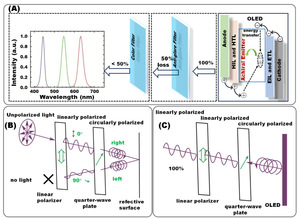
Trends in Chemistry (2023).
Graphical abstract:Emitters incorporating circularly polarized luminescence (CPL)-based organic light-emitting diodes (CP-OLEDs) are highly desirable in the pursuit of new optoelectronic applications such as 3D displays and optical data storage. In particular, emitters possessing circularly polarized thermally activated delayed fluorescence (CP-TADF) are able to achieve high efficiency in OLEDs. By further endowing multi-resonance thermally activated delayed fluorescence (MR-TADF, a subclass of TADF) with circularly polarized properties, MR-CP-OLEDs can obtain narrow emission bandwidths and may help to realize the holy grail of ultra-small bandwidth. Accordingly, this review covers the recent progress and evolution of CP-TADF emitters, their upgraded features and corresponding device technologies, as well as the challenges encountered in practical CP-OLEDs.

Materials Horizons 11.5 (2024): 1251-1260.
Graphical abstract:In this work, a proof-of-concept, liquid-crystalline CP-TADF molecule is proposed to realise high glum by taking advantage of the order inherent in liquid crystals. Employing a chiral dinaphthol-based CP-TADF molecule as the emissive unit, a pair of liquid-crystalline CP-TADF molecules (R/S-4) is synthesised via the introduction of six mesogenic moieties. The enantiomers show intense emission at about 520 nm which has clear TADF and liquid-crystalline characteristics. Both enantiomers display symmetrical elec-tronic circular dichroism (CD) and circular polarisation luminescence (CPL) signals as thin films. Impressively, relatively large glum values of 0.11 are realised for the films. Solution-processed devices were fabricated using R/S-4 as the dopants, with the TADF molecule CzAcSF as the sensitiser. The OLEDs so prepared show a very high maximum external quantum efficiency of 21.2%.
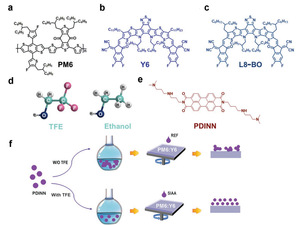
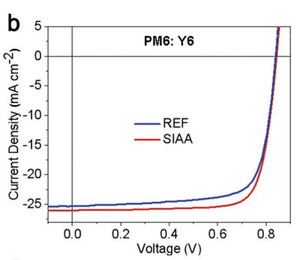
Adv. Energy Mater. 2023, 2203009
Graphical abstract: By applying N,N′-Bis{3-[3-(Dimethylamino)propylamino]propyl}perylene-3,4,9,10-tetracarboxylic diimide (PDINN) (a well-known ETL) as a demo, a solvent-induced anti-aggregation (SIAA) strategy is proposed to cope with these hurdles via the mixing of ethanol and trifluoroethanol solvents at an optimal volume ratio. In situ photoluminescence and dynamic light scattering synergistically reveals the suppressed aggregation behavior of the SIAA-treated PDINN dispersion during the film-forming process. Owing to this amendment, the film quality and electron-transport capability of the PDINN layer are remarkably enhanced. In consequence, based on the PM6:L8-BO system, a champion power conversion efficiency (PCE) of 19.0% together with an impressive fill factor of 80.6% is harvested. A 1 cm2 device with an excellent PCE of 16.6% is also fabricated using the doctor-blading SIAA-treated PDINN ink.
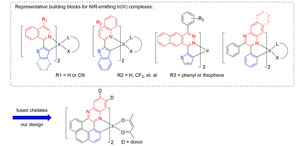
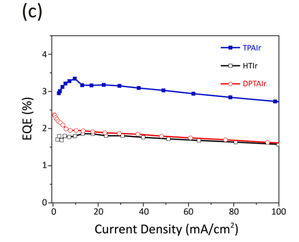
Chemical Engineering Journal 452 (2023) 138956
Graphical abstract:Herein, three new NIR-emitting iridium(III) complexes, namely TPAIr, HTIr and DPTAIr with donor-acceptor-donor (D-A-D) cheating architecture, are rationally designed and synthesized to address this issue. In these complexes, π-extended and electron-deficient phenanthro[4,5-abc]phenazine (PPz) are employed as the rigid acceptor core. Triphenylamine (TPA), n-hexylthiophene (HT) and diphenyl thiophen-2- amine (DPTA) are used as peripheral donor units, respectively. The effect of donor types on their photophysical, electrochemical and electroluminescent properties is primarily studied. It is found that the combined effect of the rigid central acceptor and peripheral donors together endow these complexes with high photoluminescence quantum yield (PLQYs) and a variational wavelength. Real NIR emission from 774 to 798 nm with PLQYs of 9–15 % and decay lifetimes as short as 0.32 μs are observed in solutions. Solution-processed organic light-emitting diodes with DPTAIr as an emitter reveals an intense NIR emission at 800 nm with an outstanding EQE of 2.98 % and a high radiance of 17,083 mW Sr−1 m−2 . More importantly, the efficiency roll-off is efficiently alleviated in the devices at high current density.